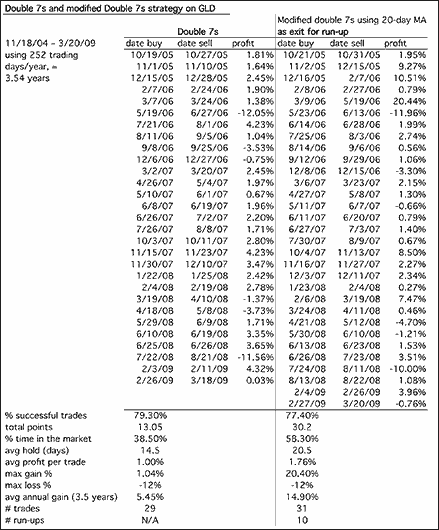Letters To The Editor
June 2009 Letters To The Editor
The editors of S&C invite readers to submit their opinions and information on subjects relating to technical analysis and this magazine. This column is our means of communication with our readers. Is there something you would like to know more (or less) about? Tell us about it. Without a source of new ideas and subjects coming from our readers, this magazine would not exist.
Address your correspondence to: Editor, Stocks & Commodities, 4757 California Ave. SW, Seattle, WA 98116-4499, or E-mail to editor@traders.com. All letters become the property of Technical Analysis, Inc. Letter-writers must include their full name and address for verification. Letters may be edited for length or clarity. The opinions expressed in this column do not necessarily represent those of the magazine. —Editor
TRADING ON A MAC
 Editor,
Editor,
Do you ever provide Traders’ Tips for Mac applications?
—Dave Rich
Durango, CO
Our Traders’ Tips section is made up by contributions from outside software developers (we don’t write them ourselves). Currently, no Mac-based developers are contributing, but we could try extending an invitation to some of the companies mentioned in the April 2009 S&C article, “Trading On A Mac” by Wallace Wang. We previously have published Traders’ Tips contributions from Linn Software for the Mac-based Investor/RT program.
Thanks for writing.
Short-Range Oscillator
 Editor,
Editor,
On your website I came across a past article about the short-range oscillator (“The Short-Range Oscillator And The Djia” by Christopher Cadbury, Stocks & Commodities, September 1995) and was curious if you had historical data for the short-range oscillator. I work for a money management firm and we have the old S&P Trendline Oscillator booklets dating back to the late 1960s, and it appears that yesterday the short-range oscillator recorded its highest reading since 1982. I am trying to confirm this and am wondering if you sell the historical data or know of anywhere I can purchase the historical data. (I called Standard & Poor’s to inquire about the data but they replied they do not keep the historical data for the short-range oscillator.)
—Ethan Brown
Sorry, we do not sell any data, but you might try researching our Traders’ Resource at www.traders.com to find out where you could find the right data.
ERRATA: FUTURES FOR YOU
Editor,
Carley Garner’s April 2009 column, “Futures For You,” inadvertently contains a computational error in the March crude oil $41 straddle example. The total cost of $7,500 ($7.50 x $10) may make sense to brokers and very seasoned traders, but for total novices and relatively new traders, $7.50 x $10 = $75. Likewise for the expiration example of the $40 put (1.00 x $10) = $10. Further, if one carries the units through the calculation, you get dollars squared, which is nonsensical.
I never get confused if I always multiply the premium by the contract units; in these two examples, we would calculate $7.50 x 1,000 barrels = $7,500 net debit, and $1.00 x 1,000 barrels = $1,000 credit. I currently hold two June 09 crude oil $60/$65 bull call spreads, and I calculate their value at the close each day.
I really enjoy this kind of article because they help confirm my understanding of the markets, and they help me teach trading to my friends.
—Ray Senkel
Tigard, OR
Carley Garner replies: I appreciate your feedback and suggestions; it is always helpful to see things from the perspective of others.
I have always said that the most difficult aspect of trading commodities is learning how each contract is quoted, and most important, how to calculate risk and reward. In the April 2009 “Futures For You” column, I preceded the math in question with the statement, “…keep in mind that each dime in price is equivalent to $10 to the trader.” Thanks to your inquiry, I discovered my error and the likely source of the confusion. The statement should have read, “…each penny in price is equivalent to $10.” With this qualifier, the calculation $7.50 in premium multiplied by $10 becomes simply (750 x $10) and is equivalent to $7,500. I can see where traders unfamiliar with the price structure of crude oil futures and options may have misconstrued the calculations, especially in light of my error. I apologize for any inconvenience that this has caused.
I encourage you to visit the free educational articles on my website at www.CarleyGarnerTrading.com in which these types of calculations on commodities and financial futures are explained in detail.
FOLLOW-UP TO DOUBLE 7s
Editor,
I have a follow-up question for Kirk Dolan related to his reply in the May 2009 Letters To S&C section.
If using the 20-day moving average as an exit, is he assuming that the price must be above the 20-day moving average (or whatever x-day moving average is found to be optimal) prior to buying? For example, this would mean that the price would need to be above the 200-day moving average and the 20-day moving average prior to buying?
—MJ
Kirk Dolan replies: No, I paid no attention to the 20-day moving average until three days after the price hit a seven-day high. The price needs to be above only the 200-day moving average to consider buying. The 20-day (or any optimal sell) is only important in my system when there is a runup after hitting the seven-day high, and these runups don’t always happen.
MORE ON DOUBLE 7s
Editor,
In the May 2009 issue in the Letters To S&C column, I mentioned that I hoped to run more tests following a reader’s question and report back. Here’s a more thorough response to the question about my modifications to Larry Connors’ Double 7s strategy, with an example spreadsheet shown in Figure 1.
1. I found it’s unrealistic to say, “Buy if the close of the next day is greater than the close on the seven-day low.” Why? Because many times the stock price will move above the previous close (implying a buy), but the close is below the previous close (indicating a sell). That means you can be whipsawed. On the other hand, if I wait to buy at the close of the next day, the results are about 3% lower (that is, the amount of successful trades and the average annual performance are 3% lower), because the closing price moves too high. My compromise was to say that any time the high of the next day rises >=0.1 above the previous close, buy at that price. You can see by the spreadsheet example in Figure 1 that the results for Gld are reasonable.
2. One important point is that because I am trying to catch possible runups, the optimal exit for one exchange traded fund (Etf) (for example, a 20-day moving average for Gld) may be very different (much looser) than that for a more volatile Etf, such as Skf (for which the optimal exit is a three-day moving average). When I purchase an Etf, I can immediately do backtesting in my program to determine the optimal x-day moving average to exit. The more volatile Etfs have tighter optimal exits. I assume many of your readers could do similar backtesting in TradeStation or another program.
—Kirk Dolan
See Figure 1 for details.
—Editor

FIGURE 1: MODIFIED DOUBLE 7S STRATEGY ON GLD FROM KIRK DOLAN
Rules (modified from Larry Connors’ rules):
- Buy only if close is > 200-day SMA.
- After hitting a seven-day low, starting the next day, buy if the high of the next day crosses $0.10 (10 cents) above the previous close.
- After hitting a seven-day high (day 1):
a) If the closes of the next three days are above the close of day 1, set a stop at the x-day moving average to trail the runup.
b) If any of the closes of the next three days is below the close of day 1, move the stop 0.1 below the low of the previous day until sold out. - Note 1: If a buy is on and price closes below the 200-day MA, do not emergency-sell unless the 50-day MA crosses below the 200-day MA.
- Note 2: Emergency sell whenever the loss > 10% based on the close of the day.
I found that the 20-day MA was the best (that is, the highest total points and highest % successful) selling point for runups.